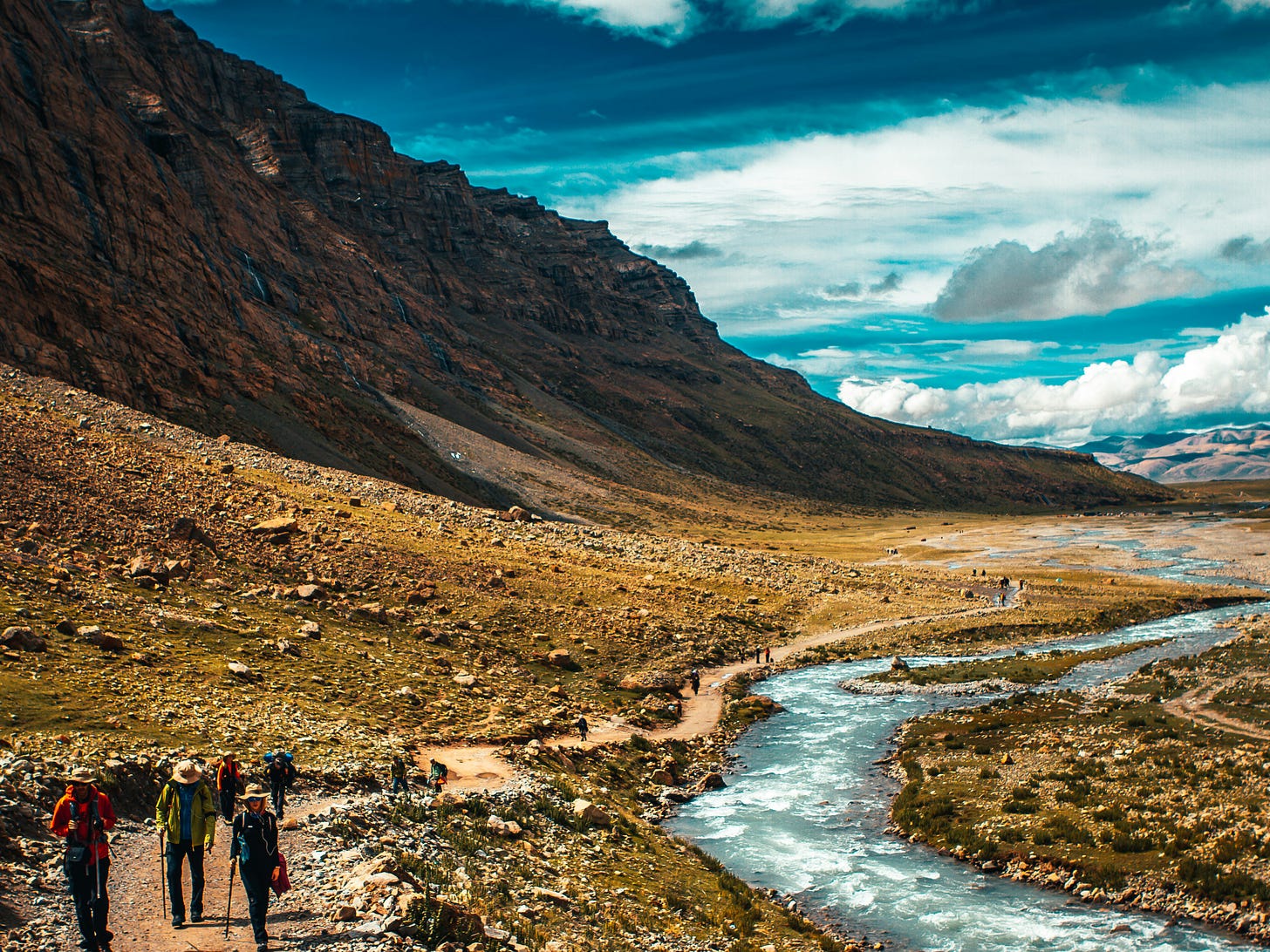On Pilgrimage and Travel: Where Does Our Venturesome Spirit Come From?
Historical and modern accounts of pilgrimages represent a useful source to analyze and speculate on the origins of humanity’s wanderlust.

“The pilgrim’s journey, unlike the travelers, never ends; it only deepens. All our life is a pilgrimage.”
-Pico Iyer
I do not doubt that subscribers of their chosen faith take seriously their beliefs and, as pilgrims, are motivated to embark on their pilgrimages to holy sites on behalf of those beliefs. However, I often wonder if the zest they feel for the pilgrimage arises from something even deeper within us that transcends religion and is something we all share as a species. After all, many of us who are not religious feel compelled to travel out of the sheer thrill of going, being on the move, and seeing what lies beyond the horizon and we even take great pleasure in visiting sacred sites. Can the nonbeliever still qualify as a pilgrim? More importantly, where does this venturesome spirit come from?
While the Greek geographer and traveler Pausanias is often credited as writing one of the first travel memoirs with his Description of Greece in the 2nd century CE, much of the modern travel narrative has its roots in the Middle Ages. Despite being labeled as a “dark age”, this period was still an unprecedented cosmopolitan time when vast numbers of people across Asia, Europe, Africa, and the Middle East intermixed their cultures. Many were actively taking part in trade, war, diplomacy, and pilgrimages that resulted in the spread of ideas in unprecedented ways. It is at this time that we first begin to see a wealth of commentary and records of people jotting down their thoughts on their travels, often in the context of holy pilgrimages. Historical accounts of pilgrimages thus represent a useful source to analyze and speculate on the origins of humanity’s wanderlust. What compelled these early pilgrims to walk across deserts and hostile territory to pay homage to the ruins and shrines of their given faiths?
The fascination with sacred sites overlays the pilgrim’s travels. A Christian woman, thought to be a nun, named Egeria or Aetheria provided one of the earliest accounts of pilgrimage to the Holy Land, in the 4th century CE. She was compelled to travel from what was then Gaul to Jerusalem and along her way paid her respects at a monastery at Mount Sinai, where Moses is said to have received the Ten Commandments. Here she described her days climbing mountains with monks and exploring the sacred landscape in much the same manner as a modern religious tourist might today. Valerius or Valerio of Bierzo, a Galician monk commenting on the manuscript of Egeria later in the 7th century gives us insight into one of the core motivations of a pilgrimage from his perspective by observing that a pilgrimage was believed to somehow prepare a pilgrim for ascendancy into heaven.

However, the deeper question and commentary I am searching for is why people took their pilgrimages in their own words which is much harder to come by in these early travel narratives. Writing nearly a millennia later after Egeria, in the 14th century the famed world traveler Ibn Batutta wrote in his days before departing for his pilgrimage or hajj to Mecca from Tangiers, Morocco that he was inspired by an inner feeling,
“Swayed by an overmastering impulse within me and a desire long cherished in my bosom to visit these illustrious sanctuaries.”
If we entertain the idea that this wasn’t a calling from God, then what is that feeling he is speaking of and where does it come from? Why do we have this restless urge within us to venture to unknown lands? Do we all have this yearning or is this exclusive to only a subset of would-be adventurers? As a self-described “anthropologist of wandering”, these are the questions I am after.
Other notable pilgrims and travelers of the Middle Ages, discussed more in a previous post on the Silk Road, included Marco Polo and the Chinese mariner and explorer Zheng He—the accounts of their travels throughout the ancient world have been incredibly important for historians. Marco Polo’s Description of the World or what more famously became The Travels of Marco Polo had the profound effect of opening the eyes of many Europeans to a larger world at the time. John Mandeville, the purported author of The Travels of Sir John Mandeville is another source, albeit far more dubious in its tales of travel through India, China, and parts of the Islamic world during this time.
While much of the descriptions from these travelers of the Middle Ages are often vivid and historically important, they are nonetheless often fixated on long descriptions of very specific topics, such as the architecture and layouts of cities—Ibn Battuta extensively describes the precise measurements of the Ka’ba in Mecca, provides pages of description about the Al-Aqsa Mosque and Dome of the Rock in Jerusalem, and gives an overview of the city of Constantinople.
Occasionally, Battuta finds a moment to give a harsh critique of a place like a marketplace at a seaside port in Constantinople where he gibes that “The bazaars in this section are good, but overlaid with all kinds of filth, and traversed by a small, dirty and filth-laden stream. Their churches too are dirty and mean.” I don’t imagine he’d be hired as today’s Rick Steves with that attitude. Likewise, Marco Polo spills plenty of ink endlessly praising how “generous” Kublai Khan was to the people he and the Mongol Empire conquered.
Thus, the modern travel narrative has come a long way, and modern readers might find much of this early descriptive style of one’s travels quite tedious and uninspiring. I must admit that I have not done a comprehensive reading of all these travel accounts and perhaps I am missing what I am looking for but we rarely get to the meat of what many modern travelogues provide us—we want to know what these experiences were like while on their journeys: who did they meet; what were the people in these places like; what were the trials and tribulations of their adventures; and how were they changed by these harrowing excursions. Most important to me is, why were they compelled to wander in the first place.
As I speculated in an earlier post, Our Ancient Narrative,
“The anthropologist in me has a strong sense that a wandering ethos—an inner urge or calling—to venture far and wide is a deeply embedded feature of our humanity and has likely played a vital role in our evolution and survival as a species...What exactly is it that captures and has captured the minds of so many wayward travelers, nomads, pilgrims, and explorers throughout history?... We’re naturally intrigued and perplexed by those who seem to willingly place themselves at risk for the mere sake of it. Why leave the comfortable abode of our homes? What could possibly be gained from throwing yourself so aimlessly into bizarre, uncomfortable, and unknown situations?”
Given our extensive evolutionary history being nomadic hunter-gatherers, I can’t help but think that part of the reason so many of us feel restless, anxious, depressed, angry, cynical, or lacking inspiration nowadays is that the structure of our society and culture is no longer fully in line with how we are physically and psychologically primed. More succinctly, as author Pico Iyer, stated,
“Nomadism is in our blood.”
We are crafted by evolution to move and are strongly compelled to seek and explore our world at a pace and rhythm that is often not conducive to how our lives are set up today. Much of modern life stifles and inhibits these urges to wander–a theme I explored more in a previous post, The Case for Slow Travel and Slow Reading in a Fast-Paced Society. Thus, I argue that our venturesome spirit runs very deep within us.
Pilgrimage relates to all of us, regardless of our chosen faiths or lack thereof. The pilgrim seeks out that which is sacred to them. For some that is the Holy Land or the Bodhi Tree. Others have imbued sports stadiums as a kind of secular shrine with hopes of one day venturing to them in a pilgrimage-like fashion.
Take the Camino de Santiago—a network of pilgrimage routes in northern Spain for instance. While I do not doubt that some intrepid travelers of this trek are on this holy route for spiritual reasons, i.e., to visit and pay homage to St. James, many are also doing this trek because there is an aura of adventure to the experience one has passing through old towns, trekking through the rolling hills of the countryside, and feeling an ocean breeze greet you as you make it to the sea. Many secular people make these same pilgrimages for presumably nonreligious reasons but can come to appreciate and value these places and these journeys as sacred.
For consideration:
● Is faith required to be a pilgrim or is it open to wider interpretation?
● What compels you to wander?
● Do you think everyone has this “venturesome spirit”?
Thanks for being a fellow traveler with me through this read. Please consider subscribing, sharing, and supporting this project—much more to follow.
Cheers!
-JSB





Wandering and traveling are wondrous ways to unwind AND discover things about ourselves, others and the world. I really enjoyed this post and the things it made me ponder. One of my all time favorite quotes is by JRR Tolkien, you may know it, “All who wander are not lost.” Thanks again.
Faith isn't required to be a pilgrim. I'm compelled to wander as part of a desire to see beauty. I don't think all of us have this venturesome spirit. Many of us are quite content to stay at home. I think age and health play a role. Younger, healthier, individuals are more apt to wander and seek new things. The US Navy has traditionally recruited a significant percentage of their sailors from the interior of the country - individuals who, at the very least, wanted to see the ocean.
On a separate note, have you ever researched the role of the printing press in the growth of travel journals? I can't help but think that the switch from copying manuscripts by hand to the use of the printing press led to more journal copies and a greater likelihood that at least one copy of a journal would survive over time.